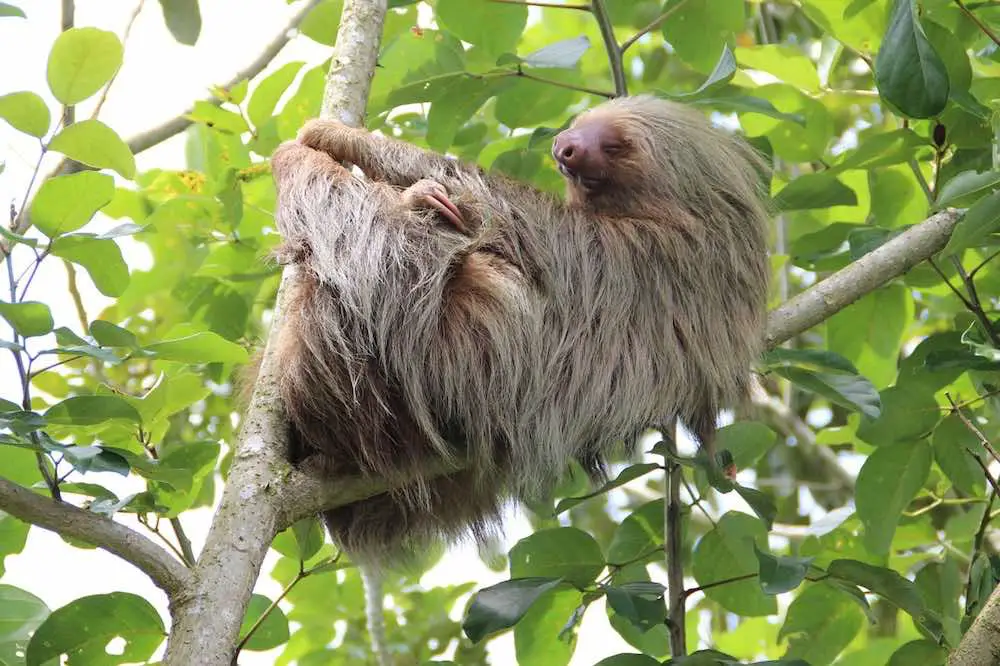
I’ve seen tons of pictures of sloths online and often wondered why are sloths green? I was sure they could not actually really be that color, and when I looked into it I was able to learn exactly why they appear to be green.
So why are sloths green? Sloths are green because their fur is covered with green algae. This grows on a sloth due to the hot, humid climate, long fur, and how still they stay. Creatures live in the algae, helping it to grow. When sloths go to the toilet they lay their eggs, and when these hatch they live in the fur too.
Above is a very brief answer to the question of why are sloths green. I’ve gone into some more detail below about each of the points, as well as how this green algae benefits the sloth.
I’ve also provided some interesting insights into how this green algae could also benefit the medical world. Keep reading to find out more!
Contents
Why Are Sloths Green?
So as I said above, sloths appear to be green in many pictures because of the green algae growing on their fur. However, underneath this green algae, they are not actually green.
Now people talk about sloths as if there is just one species, but there are in fact 6 different species of sloths, with a further 12 sub-species.
Sloths are split into two families or genera, known as the two-toed and three-toed sloths. They are named this because of the amount of toes they have on their fore limbs. Both have three on their hind limbs. There are other differences between these types of sloths, and I’ve written about them here.
These different types of sloths live in different places, and can vary in color. So although sloths may appear to be green, underneath they have their own style!
The two-toed sloth, or to give it it’s scientific name Choloepus, has two species. These are:
- Choloepus didactylus (Linnaeus’s two-toed sloth)
- Choloepus hoffmanni ( Hoffmann’s two-toed sloth)
The Linnaeus’s two-toed sloth has long greyish brown or beige fur. The Hoffman’s two-toed sloth is similar in color to the Linnaeus’s two-toed sloth. It’s fur is a medium to light brown color, and is lighter on it’s face.
Unless you really knew any different, you could be forgiven for not really being able to tell much of a difference between them. Especially when their fur is covered in green algae.
The three-toed sloth, or Bradypus as it is referred to scientifically, has four members in it’s family. These are:
- Bradypus torquatus (Maned sloth)
- Bradypus tridactylus (Pale-throated sloth)
- Bradypus variegatus (Brown-throated sloth)
- Bradypus pygmaeus (Pygmy three-toed sloth)
The maned sloth usually has a pale brown coat of fur. The fur is long, and covers an under layer of fur that is actually black and white. It has a long mane of black hair that runs down it’s neck and spreads out over it’s shoulders.
The pale-throated sloth is darker in color. It has blackish grey fur, interspersed with lighter and darker patches covering it’s body. Males have a yellow or orange patch of color on their back, with a black stripe in the middle. As the name would suggest, the pale-throated sloth has a yellow patch on it’s throat.
The brown-throated sloth is very similar in appearance to the pale-throated sloth, and they are the mostly closely related of this genus. Their long fur is generally a brownish grey color, with the fur on the throat, forehead and sides of the face much darker.
It’s name comes form the dark fur covering it’s neck. The centre of the brown-throated sloth’s face is a pale colour, with a stripe of dark fur between it’s eyes.
The pygmy sloth is quite similar in appearance to the brown-throated sloth, although it is quite a bit smaller. It has light brown coloured fur, with lighter yellowish patches.
It has dark circles around it’s eyes, and the rest of the fur on it’s face is an orange color. The fur on the throat is a light brown color, also helping to make it look like the brown-throated sloth.
So I’ve covered the actual colors of each sloth underneath the green. So let’s move on to look at some of the answers to the question of why are sloths green.
Does A Sloth’s Habitat Make It Appear Green?
A sloth’s habitat plays a huge part in why sloths are green. The sloths mentioned above live in forested areas. Over time sloths have adapted to the rainforest that they now live in. They live high up in the canopies of trees, mostly in the rainforests of South and Southeastern America.
They spend almost all of their time in these trees. They provide them with a place to sleep, and shelter from possible sloth predators. This is where they also get all of their food. Sloths can survive only on the leaves from trees.

Now what do we know about the rainforests? As the name would suggest, these forests are wet. It rains a lot here. It is also very hot all of the time. So what we have is very hot, and very humid conditions.
These conditions, as well as some of the others we will look at below are ideal for algae to grow in the sloth’s fur, hence providing the first answer to the question of why are sloths green.
In fact, the green algae on a sloth’s fur is only found on sloths living in these wet, humid conditions. Sloths living in drier habitats have been found to not have this algae growing on them.
Does the Sloth’s Long Fur Help Algae To Grow?
The length of a sloth’s far plays a big part in answering the question of why are sloths green too. Sloths have a very thick coat of fur, which covers a much shorter under fur.
The fur actually grows in the opposite direction to most other animals. This is because they spend most of their time hanging upside down. So their fur grows upwards towards their head, rather than down towards their feet.

This serves the purpose of allowing much of the rainwater in the rainforest to run down the body of the sloth and down to the rainforest below.
However, the fur of the sloth will still be wet a lot of the time. The long fur will trap some of the moisture inside, and this helps to create a breeding ground for algae to grow.
Does The Sloth’s Slowness Of Movement Make It Green?
Another answer to the question why are sloths green comes in it’s slowness of movement. Sloths get a hard time for their laziness sometimes, but this is not the whole story.
Yes sloths do move slowly. In fact they move at an average speed of 4 metres per minute, which is so slow! Sloths can swim up to three times quicker than this though!
This slowness of speed actually serves many purposes, and is interrelated to much of the sloth’s other behaviors. Sloths have an incredibly slow metabolism.
They live on mostly leaves from the trees that they live in. They can take between 30 to 50 days to digest the food that they eat. They need to move slowly to conserve energy.
This slowness of movement also helps us in understanding why sloths are green. Due to the fact they they have long, wet fur, and they stay still a lot of the time, this helps the algae to grow in their fur.
If they were moving about quickly a lot of the time, it would be much more difficult for this to happen. Staying still in these hot and humid conditions supports the growing of this algae, helping them to appear green.
Do The Creatures In The Sloth’s Fur Help The Algae To Grow?
This sounded weird to me at first when I read it, but sloths have a whole number of creatures living in their fur. When I think about it, I have heard of the ‘sloth moth‘ before, and this is exactly where this comes from. Sloths have moths, and other creatures living in their fur.
These creatures are able to build a home in a sloth’s fur due to it’s length. The algae is also an ideal place for them to stay and lay their eggs too. It’s a bit of a cycle really, and all related.
Sloths grow algae because their fur is long and damp. This is also an ideal place for creatures to live. They then promote the growth of more algae.
Researchers have found that there is more algae, which is more rich, found on the sloths that have more of these sloth moths and other creatures living in their fur.
Creatures living in a sloth’s fur include sloth moths, beetles, and a range of different flies.
Does Going To The Toilet Help To Make A Sloth Green?
One of the more well known facts about the sloth seems to be around it’s toilet habits. Due to their extremely slow metabolism, sloths do not need to go to the toilet very often. In fact they tend to go roughly once every seven to ten days.

Sloths go to the toilet at the base of the trees they live in. In this way sloths are good for the environment, as they help to fertilise the very trees that they live in.
By the time a sloth goes to the toilet, their body weight can be comprised of up to 30% waste. That is a lot of fertiliser for the trees.
The act of going to the toilet also serves another purpose too. The creatures living in these sloths will jump out while they are going to the toilet and lay their eggs in their poop.
This supports the circle of life in the rainforest, and in fact when hatched, the insects that come out of a sloths fur can then latch on to the sloths fur when they come down again to use the toilet.
This supports the ecosystem in the sloth’s fur, by having a constant cycle of creatures living within it. This almost makes a sloth sound clever!
How Does The Algae In A Sloth’s Fur Benefit Them?
So we’ve talked a lot about the algae living in a sloth’s fur, and how this answers the question why are sloths green. Sloths are good to the algae and the creatures living in their fur. They provide the creatures with a safe place to live and lay their eggs.
They also provide a stable home for this algae to grow. So what about the sloth? Does this green algae provide any benefits to them? The answer to this is a definitive yes. It does provide benefits to the sloth.

The biggest advantage to a sloth of having green algae covering it’s body is related closely to how sloths protect themselves. As I said above, sloths move very slowly, and have very little protection from predators that hunt them.
They can be attacked from above by eagles, and from below by members of the wild cat family, such as margays. These can actually climb trees well, so the poor sloth needs to keep watch both from above and from below.
So then, the sloth needs to camouflage itself well. This is one of the reasons it barely moves, only coming down to use the toilet. The less it moves, hiding amongst the branches and leaves of the trees, the less likely it is to be eaten!
Sloths can also snack on the bugs living in their fur if they are short of food. To be honest this will rarely happen, as there is more than enough of the type of food they need in the trees that they live in.
However, sloths can and do eat a range of insects if they need to supplement their diet.
Can The Algae In A Sloth’s Fur Cure Diseases?
This sounds mad right? There have been several studies to show that not only does the green algae covering sloths provide them with an essential form of camouflage, but that it can be used for other things too.
Now sloths are not particularly dangerous to humans in the first place, but could it be that they can actually help to cure them of diseases?
There are some studies that have shown fungus found in the sloths algae and fur could protect against parasites that cause malaria. There has also been discussion of how some of the chemicals in a sloth’s fur could be used to fight illnesses such as breast cancer.
No medications actually being used right now have been developed from this, but it is something that is certainly being studied right now.
Summing Up
So there you have it. A comprehensive answer to the question of why are sloths green. They are covered in green algae, which grows on them for a number of reasons.
Sloths live in hot and humid climates, and because they don’t move too much, and have long fur, this provides ideal conditions for algae to grow.
This algae, and the sloth’s fur, in turn provide the perfect space for a whole host of creatures to live. This in turn supports the growing of more algae.
Going to the toilet even supports this, as insects can lay their eggs in the sloths poop, and then climb aboard the sloth once they have hatched and the sloths come back down to use the toilet again.
This green algae helps a sloth by providing it with a great deal of camouflage to help protect them against predators. They can also snack on the creatures living in them too.
Findings have shown that this green algae could be used in the important fight against a number of illnesses and diseases.
I hope you have found the information here useful. If you have any questions, or would like to add anything then please leave a comment below.

